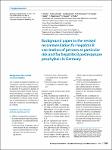Background paper to the revised recommendation for hepatitis B vaccination of persons at particular risk and for hepatitis B postexposure prophylaxis in Germany
Harder, Thomas
Remschmidt, Cornelius
Falkenhorst, Gerhard
Zimmermann, Ruth
Hengel, Hartmut
Ledig, Thomas
Oppermann, Hanna
Zeuzem, S.
Wicker, Sabine
Die Ständige Impfkommission (STIKO) empfiehlt die Impfung von Risikogruppen gegen Hepatitis B (Indikationsimpfung) und die Postexpositionsprophylaxe. Diese Empfehlung wurde überarbeitet, unter Fokussierung auf i) die Risikogruppen, ii) die Schutzdauer nach Grundimmunisierung und iii) den Schwellenwert von Anti-HBs als Impferfolgskriterium. Risikogruppen wurden mittels orientierender Literaturrecherche identifiziert. Drei Indikationsgruppen wurden beispielhafte Personengruppen zugeordnet. Systematische Literaturrecherchen zur Schutzdauer nach Grundimmunisierung identifizierten eine randomisierte kontrollierte Studie (RCT) und 9 Kohortenstudien. Die Evidenzqualität wurde mittels Grading of Recommendation, Assessment, Development, and Evaluation (GRADE)-Methodik bewertet. Die Qualität der Evidenz aus RCTs dafür, dass Hepatitis B für eine Dauer von 15 Jahren nach erfolgreicher Grundimmunisierung (Anti-HBs ≥ 10 IE/l) mit einer Effektivität von 96 % für chronische Hepatitis B, 89 % für HBsAg-Positivität und 73 % für isolierte Anti-HBc-Positivität verhindert wird, wurde als sehr gering bewertet. Sieben Kohortenstudien zeigten, dass für eine Dauer von maximal 10 Jahren unter mit Deutschland vergleichbaren Bedingungen keine Fälle von klinischer Hepatitis B oder HBsAg-Positivität auftraten, wenn Anti-HBs ≥ 10 IE/l als Impferfolgskriterium verwendet wurde. Weniger als 1 % der geimpften Probanden hatten isolierte Anti-HBc-Positivität. Die GRADE-Bewertung von 2 Kohortenstudien ergab, dass Evidenz von sehr geringer Qualität dafür vorliegt, dass die Verwendung des Impferfolgskriteriums Anti-HBs ≥ 100 IE/l zu einer geringeren Häufigkeit von Anti-HBc-Positivität führt als die Verwendung des Kriteriums Anti-HBs ≥ 10 IE/l. Die Impfempfehlung wurde entsprechend dieser Evidenzlage überarbeitet. The German Standing Committee on Vaccination (Ständige Impfkommission, STIKO) recommends vaccinating risk groups against hepatitis B and gives advice for postexposure prophylaxis. STIKO has recently revised this recommendation, focusing on: (i) classification of risk groups, (ii) duration of protection after primary immunization, and (iii) anti-HBs threshold that defines successful hepatitis B vaccination. Orientating literature reviews were performed for the first objective. Examples of population subgroups at increased risk were identified and classified into three indication groups. Systematic reviews on the duration of vaccine-induced protection identified one randomized controlled trial (RCT) and nine cohort studies. When applying the grading of recommendation, assessment, development, and evaluation (GRADE) methodology, evidence from RCTs was considered of very low quality regarding the question of whether hepatitis B can be prevented for 15 years after successful primary vaccination (anti-HBs ≥ 10 IU/l) with a vaccine efficacy of 96 % against chronic hepatitis, 89 % against HBsAg positivity, and 73 % against isolated anti-HBc positivity. However, seven cohort studies showed that no cases of clinical hepatitis B or HBsAg positivity occurred during a maximum follow-up period of 10 years in settings comparable to the situation in Germany when anti-HBs ≥ 10 IU/l was used to indicate vaccination success. Less than 1 % of vaccinated study participants had isolated anti-HBc positivity. GRADE assessment of two cohort studies revealed that evidence of very low quality exists that the use of anti-HBs ≥ 100 IU/l to measure vaccination success leads to a lower frequency of anti-HBc positivity during follow-up than the use of anti-HBs ≥ 10 IU/l. The recommendation was revised according to this evidence.
Dateien zu dieser Publikation
Keine Lizenzangabe

